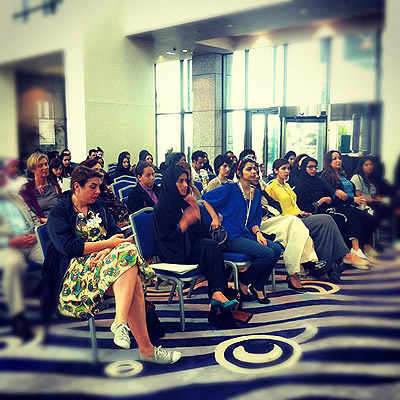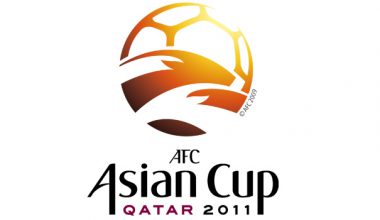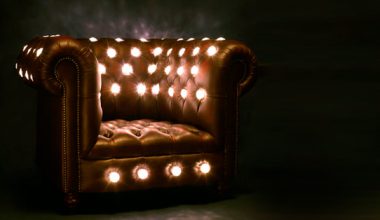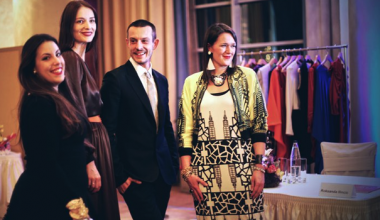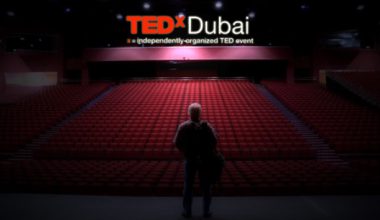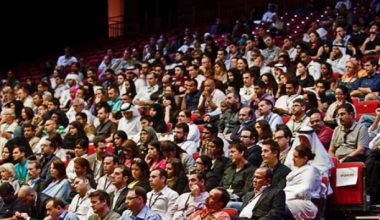Nuqat's 2012 Design Conference, 'The Lost City of Arabesque', attempted to tackle the rift between original Arabesque design and modern and contemporary ones.
While contemporary Arabesque designs are clearly inspired and derived from the ancient arts of the region, with time (and globalization), modern Arab identities become an amalgam of different cultures. Though this is not necessarily a negative thing, it is so only when the modern Arab identity becomes obsolete, and not so much "Arab."
The lecturers at the conference, all notable in their respective fields, explored the different aspects to this issue, whether it was through photography, typography, furniture design and even jewelry design.
Each and every person at the conference, from lecturer to attendee, returned home with at least one question answered: "What makes a contemporary Arab identity?"
DAY 1
Nuqat’s exposition hosted on the 17th of March in Dubai was a day filled with inspirational and motivational as well as informative speeches that left us walking away unable to figure out which speaker left a greater imprint in our minds.

Arabish by Salem Al Qassemi (Graphic Designer, Artist)
Kicking off The Lost City of Arabesque event in Dubai was guest speaker Salem Al Qassemi. The founder of Fikra, which is a design studio specializing in bilingual typography and identity creations, started off strong with his topic of the day, "Arabish".
Al Qassemi indirectly tackled the issue of Western influence in our society. Al Qassemi looked at how the Arab culture toys with the usage of numbers as letters in the internet language.

Role of Design in Performance by Azza Fahmy (Jewelry Designer)
Second to take the stage was the renowned Egyptian jewelry designer Azza Fahmy. Fahmy spoke of the role of design in performance. Fahmy spoke of the influence behind her jewelry when designing them. “I drive inspiration from culture for my collections”. A strong, thought-provoking presentation on what has happened to Arab culture and identity as well as our originality.
Fahmy announced the launch of a new design school based in Egypt to help inspire and raise the standards of creative design in the Arab world.

Being Arab by Alfred Tarazi (Artist)
Alfred Tarazi was one of the standouts of the day. Tarazi is an artist from Lebanon whose passion ranges from photography to sculpture. Tarazi draws a lot of inspiration from the traumas resulted from the Lebanese civil war. Alfred Tarazi went back to his roots to fish for his identity of "being Arab", which is the title of his seminar.
Tarazi stated some powerful comments about the Arab identity and its place in the world: “We, the Arabs, are losing the power of representation constantly”. He also mentioned that “…the Arab world has lost 50 years in development compared to the rest of the world” and mentioned how “…a great civilization is only known through what they produce”.
Some of the things he had said such as how the Arab world lacked a sense of citizenship made for some great discussions.
Oriental vs. Occidental by Ahmad Konash (Director)
Ahmad Konash followed with a presentation that was very much relatable to the topic of Tarazi. Konash is a director whose work is heavily shaped by his interest in film, photography and the ever-fading Middle Eastern culture.
Konash’s seminar titled "Oriental vs Occidental" looked at the past and how it has shaped our present. Konash toyed with the idea of what would our region be if the Ottoman Empire hadn’t fallen? "What if the Ottoman Empire didn't fall…? We would be the USA: United States of Arabia."
The Lost City by Karim Bekdache (Architect)
Last speaker of the day before the debates was Karim Bekdache. Bekdache is an architect who studied in Paris, France, but works in Beirut, Lebanon. The “Karim Bekdache Showroom” was founded in 2010 and specializes in design furniture from the 50’s, 60’s and 70’s as well as original urban pieces that survived both the civil war and the reconstruction of Beirut. In his lecture, he explored the Arab world through its architecture.
DAY 2

Arabesque, Identity & Arabic Typography by Tarek Atrissi (Type and Graphic Designer)
Internationally renowned Arabic typographer and graphic designer, Tarek Atrissi, began his talk by discussing the misconceptions of colors and icons in the Arab world, as well as the lack of simplicity. He mentioned Bram de Does, a Dutch type designer who focused on ornamentation in his work, who had a mathematical, systemized approach to looking at patterns. Through his work, Bram de Does managed to reach a conclusion that, as Atrissi explains, “the Arabs knew thousands of years ago.” He goes further by explaining that the modern Arab world lacks studying, composing, and analyzing work manually, as opposed to limiting ourselves with digitized design.
Atrissi recently co-founded a foundation that aims to explore Arab identity through the platform of design called, “Kaflab”. The foundation’s first project, Al-Kafiye, looks at the strongest graphic symbol in the Arab world – the keffiyeh, or ghetra – and how it has developed into becoming a bold fashion or political statement. He invites artists worldwide to join this exploration of a multifaceted design element via the foundation’s website: www.kaflab.org
Atrissi wrapped up his lecture by urging Arabs to invest in cultural revenue, and not just commercial revenue. He also explained that design criticism should be embedded in our culture, and to continue exploring our own identities through urban design such as street art, poster design, and ornamentation seen on trucks in the region.
Born in Beirut, and now based out of the Netherlands, where he runs his own design studio, Atrissi focuses mainly on cultural design.

Arabesque Through the Lens of a Trend Spotter by Plus Aziz (Musician and Trend Analyst)*
A self-confessed entrepreneurial musician and brandologist, the New York City based trend analyst, Plus Aziz, gave an insightful lecture on how trends are driven by human emotions and their motivations. He gave his audience a more scientific approach to trends, exploring how they are all connected in a strategic way.
He presented several cultural examples to further explain his analysis. These examples all had a few factors in common: they were all currently active, homegrown, and specific.
The first was the last keffiyeh maker, who is currently based in Hebron. This homegrown business, whose product became a trend throughout the Arab world and its political uprisings, is an example of national pride. It also exemplifies local talent and craftsmanship.
The second example given was Arab graffiti, an underrated form of art and expression that he explained as "hybridity". He shared the work of eL Seed, a renowned artist who explores his identity through his work in Arabic calligraphy used as street art. As Aziz explained, eL Seed’s work is an example of the preservation of language and form.
He shared several other forms of cultural trends, including homegrown expressive music, local art exhibitions, and TV shows. Aziz urged his audience to continue expressing their own culture through these trends, and to share any examples they might think of with him via Twitter at @PlusAziz.
*Note: Plus Aziz's lecture was scheduled for Day 2, but took place on Day 3.
– Day 1 Coverage by Ghadeer Al Otaibi; Day 2 Coverage by Rahab Al-Majed
Photos courtesy of Nuqat Instagram

